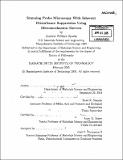| dc.contributor.advisor | Scott R. Manalis and Anne M. Mayes. | en_US |
| dc.contributor.author | Sparks, Andrew William, 1977- | en_US |
| dc.contributor.other | Massachusetts Institute of Technology. Dept. of Materials Science and Engineering. | en_US |
| dc.date.accessioned | 2008-02-28T16:07:12Z | |
| dc.date.available | 2008-02-28T16:07:12Z | |
| dc.date.copyright | 2005 | en_US |
| dc.date.issued | 2005 | en_US |
| dc.identifier.uri | http://dspace.mit.edu/handle/1721.1/30249 | en_US |
| dc.identifier.uri | http://hdl.handle.net/1721.1/30249 | |
| dc.description | Thesis (Ph. D.)--Massachusetts Institute of Technology, Dept. of Materials Science and Engineering, 2005. | en_US |
| dc.description | Includes bibliographical references (p. 109-116). | en_US |
| dc.description.abstract | All scanning probe microscopes (SPMs) are affected by disturbances, or mechanical noise, in their environments which can limit their imaging resolution. This thesis introduces a general approach for suppressing out-of-plane disturbances that is applicable to non-contact and intermittent contact SPM imaging modes. In this approach, two distinct sensors simultaneously measure the probe-sample separation: one sensor measures a spatial average over a large sample area while the other responds locally to topography underneath the nanometer-scale probe. When the localized sensor is used to control the probe-sample separation in feedback, the spatially distributed sensor signal reveals only topography. This technique was implemented on a scanning tunneling microscope (STM) and required a custom micromachined scanning probe with an integrated interferometer for the spatially averaged measurement. The interferometer design is unique to SPM because it measures the probe-sample separation instead of the probe deflection. A robust microfabrication process with a novel breakout scheme was developed and resulted in 100 % device yield. For imaging, an STM setup with optical readout was built and characterized. The suppression improvement over conventional SPM imaging was measured to be 50 dB at 1 Hz, in agreement with predictions from classical feedback theory. Images are presented as acquired with each sensor signal in several environments, and the interferometer images show remarkable clarity when compared with the conventional tunneling images. | en_US |
| dc.description.abstract | (cont.) The out-of-plane noise floor with this technique on the home-built microscope was 0.1 i rms. The results of this work suggest that the resolution of STM and other SPM modes, notably tapping mode atomic force microscopy (AFM), can be substantially improved, allowing low noise imaging of nanoscale topography in noisy environments and potentially enabling repeatable atomic scale imaging in ambient conditions. | en_US |
| dc.description.statementofresponsibility | by Andrew William Sparks. | en_US |
| dc.format.extent | 116 p. | en_US |
| dc.language.iso | eng | en_US |
| dc.publisher | Massachusetts Institute of Technology | en_US |
| dc.rights | M.I.T. theses are protected by copyright. They may be viewed from this source for any purpose, but reproduction or distribution in any format is prohibited without written permission. See provided URL for inquiries about permission. | en_US |
| dc.rights.uri | http://dspace.mit.edu/handle/1721.1/30249 | en_US |
| dc.rights.uri | http://dspace.mit.edu/handle/1721.1/7582 | |
| dc.subject | Materials Science and Engineering. | en_US |
| dc.title | Scanning probe microscopy with inherent disturbance suppression using micromechanical systems | en_US |
| dc.type | Thesis | en_US |
| dc.description.degree | Ph.D. | en_US |
| dc.contributor.department | Massachusetts Institute of Technology. Department of Materials Science and Engineering | |
| dc.identifier.oclc | 60822281 | en_US |
